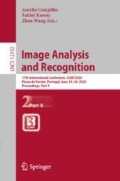Abstract
Identification and extraction of individual modes in non-stationary multicomponent signals is a challenging task which is shared by several applications, like micro-doppler human gait analysis, surveillance or medical data analysis. State-of-the-art methods are not capable yet to correctly estimate individual modes if their instantaneous frequencies laws are not separable. The knowledge of time instants where modes interference occurs could represent a useful information to use in separation strategies. To this aim, a novel time-domain method that is capable of locating interferences is investigated in this paper. Its main property is the use of multiscale energy for selecting the best analysis scale without requiring either the use of time-frequency representations or imaging methods. The performance of the proposed method is evaluated through several numerical simulations and comparative studies with the state of the art Rényi entropy based method. Finally, an example concerning a potential application to simulated micro-doppler human gait data is provided.
Access this chapter
Tax calculation will be finalised at checkout
Purchases are for personal use only
Notes
- 1.
In [6] it has been shown that the energy of the spectrogram of a multicomponent signal computed with respect to the frequency axis is itself a multicomponent signal, whose frequencies depend on the sums and differences of the original frequencies.
References
Auger, F., Flandrin, P.: Improving the readability of time-frequency and time-scale representations by the reassignment method. IEEE Trans. Sig. Proc. 43, 1068–1089 (1995)
Baraniuk, R.G., Flandrin, P., Janssen, A.J.E.M., Michel, O.J.J.: Measuring time-frequency informations content using Renyi entropies. IEEE Trans. Inf. Theory. 47(4), 1391–1409 (2001)
Barkat, B., Abed-Meraim, K.: Algorithms for blind components separation and extraction from the time-frequency distribution of their mixture. EURASIP J. Adv. Signal Process. 2004(13), 1–9 (2004). https://doi.org/10.1155/S1110865704404193
Bruni, V., Della Cioppa, L., Vitulano, D.: An automatic and parameter-free information-based method for sparse representation in wavelet bases. Mathematics and Computers in Simulation, in press (2019)
Bruni, V., Della Cioppa, L., Vitulano, D.: An entropy-based approach for shape description. In: Proceedings of EUSIPCO 2018, 2018-September, pp. 603–607 (2018). https://doi.org/10.23919/EUSIPCO.2018.8553507
Bruni, V., Tartaglione M., Vitulano, D.: On the time-frequency reassignment of interfering modes in multicomponent FM signals. In: Proceedings of EUSIPCO 2018, 2018, pp. 722–726 (2018). https://doi.org/10.23919/EUSIPCO.2018.8553498
Daubechies, I., Lu, J., Wu, H.T.: Synchrosqueezed wavelet transforms: an empirical mode decomposition-like tool. Appl. Comput. Harmon. Anal. 30(2), 243–261 (2011)
Ding, Y., Tang, J.: Micro-Doppler trajectory estimation of pedestrians using a continuous-wave Radar. IEEE Trans. Geosci. Remote Sens. 52(9), 5807–5819 (2014)
Huang, N.E., et al.: The empirical mode decomposition and the Hilbert spectrum for nonlinear and non-stationary time series analysis. Proc. R. Soc. Lond. A 454, 903–995 (1998). https://doi.org/10.1098/rspa.1998.0193
Lerga, J., Saulig, N., Lerga, R., Milanović, Ž.: Effects of TFD thresholding on EEG signal analysis based on the local Rényi entropy. In: 2017 2nd International Multidisciplinary Conference on Computer and Energy Science (SpliTech) (2017)
Li, Z., Martin, N.: A time-frequency based method for the detection and tracking of multiple non-linearly modulated components with birth and deaths. IEEE Trans. on Sig. Proc. 64, 1132–1146 (2016)
Lyonnet B., Ioana, C., Amin, M.G.: Human gait classification using microDoppler time-frequency signal representations. In: 2010 IEEE Radar Conference, Washington, DC, pp. 915-919 (2010). https://doi.org/10.1109/RADAR.2010.5494489
Meignen, S., Oberlin, T., McLaughlin, S.: A new algorithm for multicomponent signal analysis based on Synchrosqueezing: with an application to signal sampling and denoising. IEEE Trans. Signal Process. 60, 11 (2012)
Natarajan, B.K.: Filtering random noise from deterministic signals via data compression. IEEE Trans. Signal Process. 43(11), 2595–2605 (1995)
Rissanen, J.: Modeling by shortest data description. Automatica 14, 465–471 (1978)
Sakamoto, T., Sato, T., Aubry, P.J., Yarovoy, A.G.: Texture-based automatic separation of echoes from distributed moving targets in uwb radar signals. IEEE Trans Geos. Rem. Sen. 53, 1 (2015)
Sucic, V., Saulig, N., Boashash, B.: Analysis of local time-frequency entropy features for nonstationary signal components time support detection. Dig. Sig. Proc. 34, 56–66 (2014)
Author information
Authors and Affiliations
Corresponding author
Editor information
Editors and Affiliations
Rights and permissions
Copyright information
© 2020 Springer Nature Switzerland AG
About this paper
Cite this paper
Bruni, V., Cioppa, L.D., Vitulano, D. (2020). A Multiscale Energy-Based Time-Domain Approach for Interference Detection in Non-stationary Signals. In: Campilho, A., Karray, F., Wang, Z. (eds) Image Analysis and Recognition. ICIAR 2020. Lecture Notes in Computer Science(), vol 12132. Springer, Cham. https://doi.org/10.1007/978-3-030-50516-5_4
Download citation
DOI: https://doi.org/10.1007/978-3-030-50516-5_4
Published:
Publisher Name: Springer, Cham
Print ISBN: 978-3-030-50515-8
Online ISBN: 978-3-030-50516-5
eBook Packages: Computer ScienceComputer Science (R0)

